This post contains affiliate links. If you choose to purchase I will receive a small commission at no extra cost to you. I use the funds to buy yarn and make more free patterns! I greatly appreciate your support. For more info please see my Terms & Conditions. Thank You!
This guide to crochet hooks will teach you all about the different parts of a crochet hook, the types of crochet hooks, what they are made of, how to use them, and hook size! This crochet lesson is great for beginners, but is useful for all skill levels to learn about the main tool for the craft of crochet.
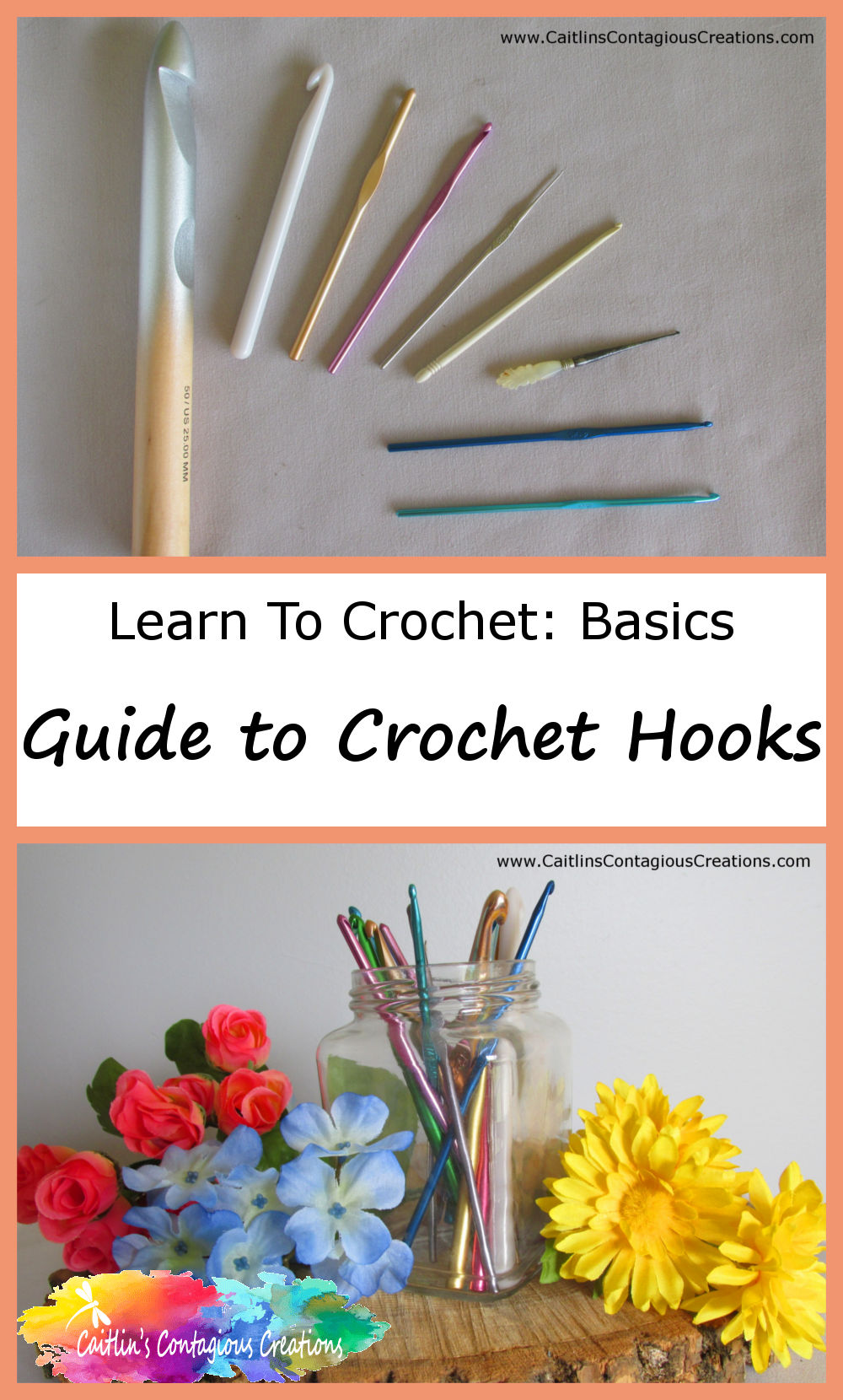
Anatomy of A Crochet Hook
There are several parts of a crochet hook. The parts are broken down into two main sections; the body of the hook and the head of the hook. All hooks have most of these parts (I’ll tell you which part is optional below).
The Head of A Crochet Hook
The photo below concentrates on the main parts of the head of a crochet hook.
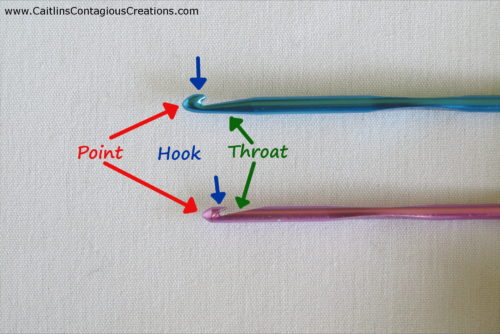
The point or tip of the hook is on the very end of the hook. It is pointed to help insert the hook into the stitches you are working. The pointy-ness of the hook varies based on who made the hook.
The hook is the part of this crochet tool, used to grab the yarn and pull it to create the stitches. The yarn rests in the groove under the hook once it has been grabbed.
Once the stitch is started, it slides down the throat of the crochet hook to the shank. This ensures the stitch is the proper size.
The Body of A Crochet Hook
The next photo in the guide to crochet hooks, focuses on the main parts of the body of the hook.
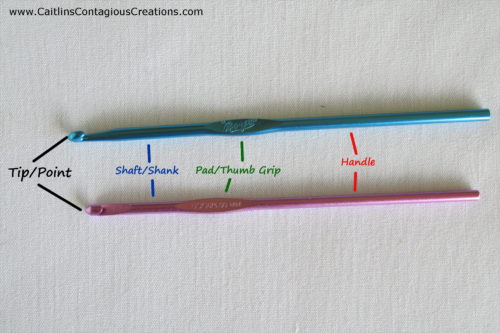
The body is made up of the shaft, the thumb rest, and the handle.
The shaft also known as the shank is the part of the crochet hook that’s cylindrical, it is where the stitches get their size. The size of the shank is what determines the size of the stitches. When you check the size of a hook, this is the part of the hook that’s been measured. We get into sizes a bit further down, so for now understand that this is the part of the hook the size refers to.
The thumb rest, also called the grip, is an optional part. Some hooks have a flattened out place where you may grip the hook. There are hooks out there that do not have this flattened section; the shank just goes right into the handle.
The handle is the final part of the body in this guide to crochet hooks. This is the part of the hook that is held in your hand, usually by your ring and pinky fingers, depending on your grip.
Holding Your Crochet Hook
There are two ways to hold your crochet hook. Neither grip is better or worse than the other. This is purely personal preference. I highly recommend experimenting with the way you hold your crochet hook, and the yarn. The way you hold your yarn will effect your tension; find something comfortable where the yarn slides through your fingers freely.
The first way is called the pencil grip, and as you can imagine it is very similar to the way many people hold their pencil.
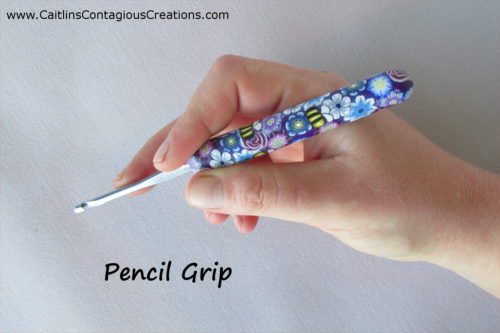
The second way to hold your crochet hook is known as the knife grip. This is how I personally hold my hook.
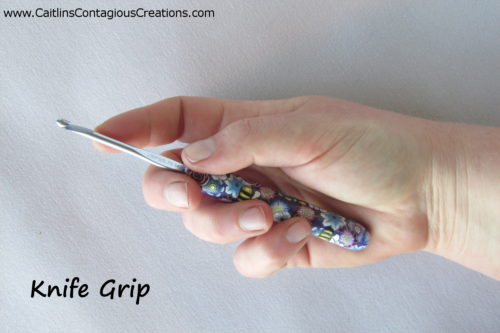
I recommend trying both ways to see which feels more natural for your hands. Holding your crochet hook and yarn is another one of those personalized experiences, where it is a little different for everyone.
Crochet Hook Sizes
How to Know The Size
Crochet hook sizes are measured 1 of 2 ways. If you live in the United States (where we use standard sizing), crochet hooks are measured by a letter or number. Crochet hooks are also measured in millimeters, also known as metric sizing.
A set of crochet hooks usually consist of B1/2.25mm, C2/2.75mm, D3/3.25mm, E4/3.5mm, F5/3.75mm, G6/4mm, 7/4.5mm, H8/5mm, I9/5.5mm, J10/6mm, and K10.5/6.5mm. These are the most commonly used sizes, but there are others too. As the numbers get bigger, the diameter of the shank gets bigger.
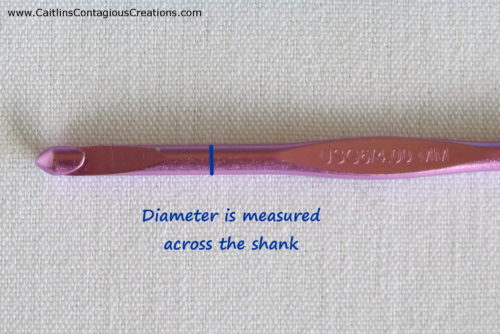
Most brands and types of crochet hooks are marked as to what size they are. The standard and the metric sizes are sometimes found together. Other hooks might have only one or the other.
The markings on the hook are not the only way to tell what size hook you have. Download the chart below and you can have a copy to put in your project bag for free!
You could also purchase a size ruler, like the one in this set 🙂 It’s easy to keep in your project bag, and has a gauge ruler too!!
The size of a crochet hook is extremely important. The size of the hook determines the size of the stitches, which in turn impacts the size of whatever you are making.
Crochet patterns usually specify which yarn size and hook size to use to achieve a certain finished project size. This can be especially important when crocheting a garment, as you want it to be the proper size to ensure it fits.
Tapered Vs In-Line Crochet Hooks
Crochet hooks can be divided into 2 main types; tapered crochet hooks and in-line crochet hooks. This terminology refers to the shape of the throat of the crochet hook.
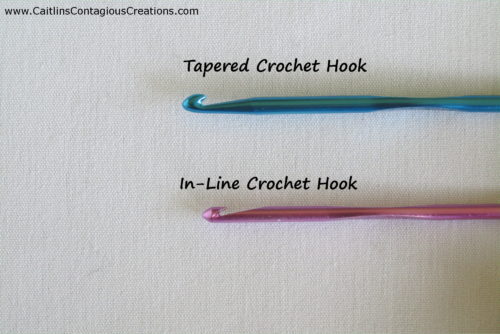
The blue hook in the above photo is the tapered hook. Notice the way the throat of the hook starts small right under the hook and then grows in diameter to the size of the shank? That is the main characteristic difference of the tapered crochet hook.
It is important when working with this style of hook to make sure every stitch slides down to the shank before moving on to the next stitch. Since the hook tapers, it is easy to end up with stitches that are too small because they weren’t made around the proper spot of the hook.
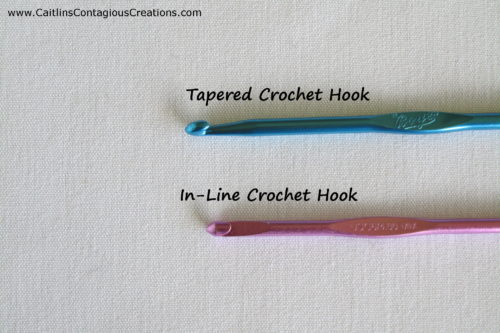
The pink hook in the above photo you will notice that the head and throat of the hook is the same diameter as the shank. A bit is cut out to make the hook and the groove.
It is still a good habit to ensure you slide a stitch all the way down to the shank when using this type of hook.
The type of hook you prefer is half personal preference, and half exposure. It has been my experience that people who learn on an in-line hook tend to prefer them; however the same can be said of the people who learn on a tapered hook. I learned on the in-line, and have tried working with a tapered hook, but I prefer the in-line style of hooks.
What’s It Made Of?
Crochet hooks can be made from lots of types of things; aluminum, wood, plastic and acrylic are some of the most common types of hooks.
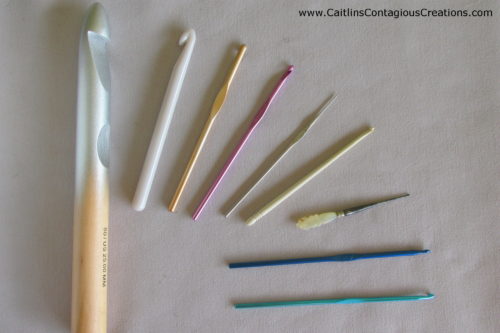
Aluminum Hooks
Many people start with aluminum hooks. They are easy to hold, not too heavy, but not so light you will break them either. They tend to work well with a variety of fiber types and are great for beginners.
You can find aluminum hooks in both the tapered and in-line variety. Two of the most common types of aluminum hooks are Boye Hooks (tapered) and Susan Bates (in-line).
Wooden Hooks
Wooden crochet hooks tend to work best for slippery types of yarn. The additional friction of the wood helps keep very smooth yarns from sliding right off the hook.
Wood is also warmer to work with, but trade off is that it isn’t always as smooth against your hands as an aluminum hook would be.
This set of Radiant Wooden crochet hooks has every size you’ll need, and they are beautiful and well made!!
Plastic/Acrylic Hooks
Crochet hooks can be made from plastic or acrylic too. This material is lightweight to use. It has good slide for yarn, and is generally easy to use.
Their strength is also their weakness though. Plastic hooks do tend to have a bit of bend in them; which can be a good thing… BUT they also break.
This set of plastic crochet hooks from Lion Brand, is just like the set I first learned with.
Additional Hook Options
This guide to crochet hooks wouldn’t be complete if I didn’t tell you some other valuable crochet hook options and information.
Handle Types
Crochet hook handles can be standard (just like in all the photos above). This means the handle is likely the same size as or very close in size to the gauge of the crochet hook. In other words, the smaller the crochet hook diameter, the smaller the handle diameter.
For those of us who like to crochet for long periods of time, or have achy hands they have “Ergonomic Crochet Hooks”. These are crochet hooks with larger diameter handles so that the hook hand doesn’t have to strain as much while crocheting.
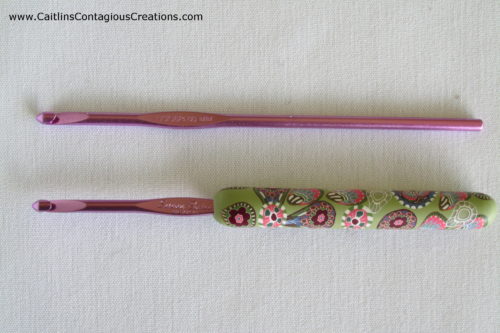
One of the most popular ergonomic crochet hooks are the Clover Amour hooks. They have an aluminum hook with a rubber handle. The rubber makes the grip super comfy and easy to hold.
My personal favorite ergonomic hook set is a set of aluminum Susan Bates hooks that have been wrapped with polymer clay. The clay makes up the handle of the hook, and is a thicker diameter than the hook itself.
Tunisian Crochet Hooks
No guide to crochet hooks is complete without mentioning Tunisian Crochet Hooks. Tunisian crochet is kind of like a mixture of crochet and knitting. And it requires a special kind of long handled crochet hook.
Tunisian crochet hooks can be made from the same materials as regular crochet hooks.
They can also be purchased in several ways. 1 way is to purchase a single stiff kind of hook (this style looks a lot like a single knitting needle with a hook on the end). This hook is good for beginners.
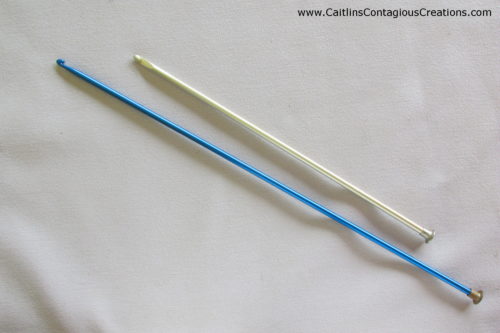
Tunisian crochet hooks do not have to be rigid like a knitting needle though. They can also have a cable attached at the end of the hook. This cable may come in several sizes. Having a longer cable means your hook can hold more stitches at once and allows you to make larger projects. Click here for an example of this type of hook.
Tunisian crochet hooks can also be purchased as an interchangeable set. Most of these sets come with a variety of crochet hook sizes; each hook can be joined to a cable, which acts as the handle of the Tunisian hook. These sets are useful because you have various hook and cable sizes to choose from, meaning you can make a wider variety of projects.
This interchangeable Tunisian crochet hook set is a really good one!
Steel Crochet Hooks
Steel crochet hooks are a just like regular crochet hooks, except the hooks are VERY small. These hooks are designed to work with finer threads and yarns. They are often used for doily patterns and other very fine crochet techniques.
This set of steel crochet hooks is very popular
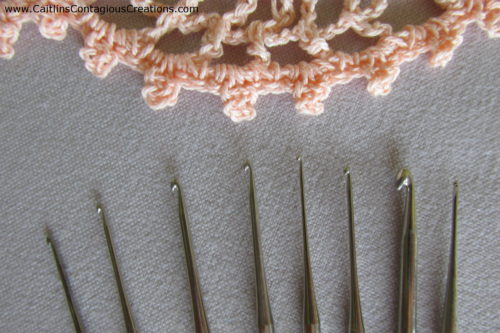
Guide to Crochet Hooks: What’s Next?
Now that you are aware of some of the different styles and types of hooks and how to hold them, it’s time to start crocheting!!
After you’ve got a hook and yarn check out each of the tutorials I’ve listed below. They are all beginner stitch tutorials. Start at the top and check out each one down the list to learn all the basics!
Joining Your Yarn To Your Hook (The First Step To EVERY Project)
The Half Double Crochet Stitch
Please Share!
If you’ve enjoyed this guide to crochet hooks, please share it on your Facebook and Pinterest so others can find and enjoy it too!!
Happy Hooking!!
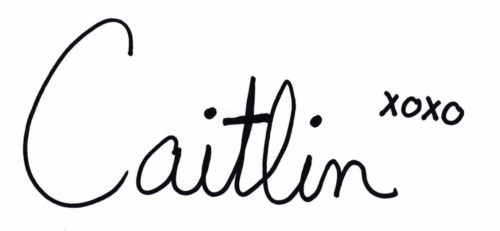
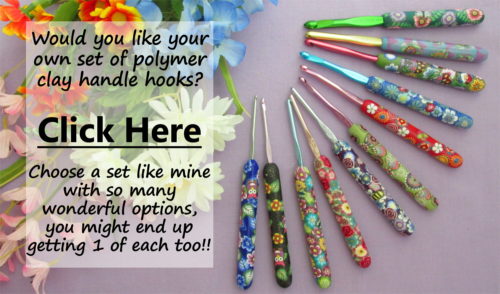

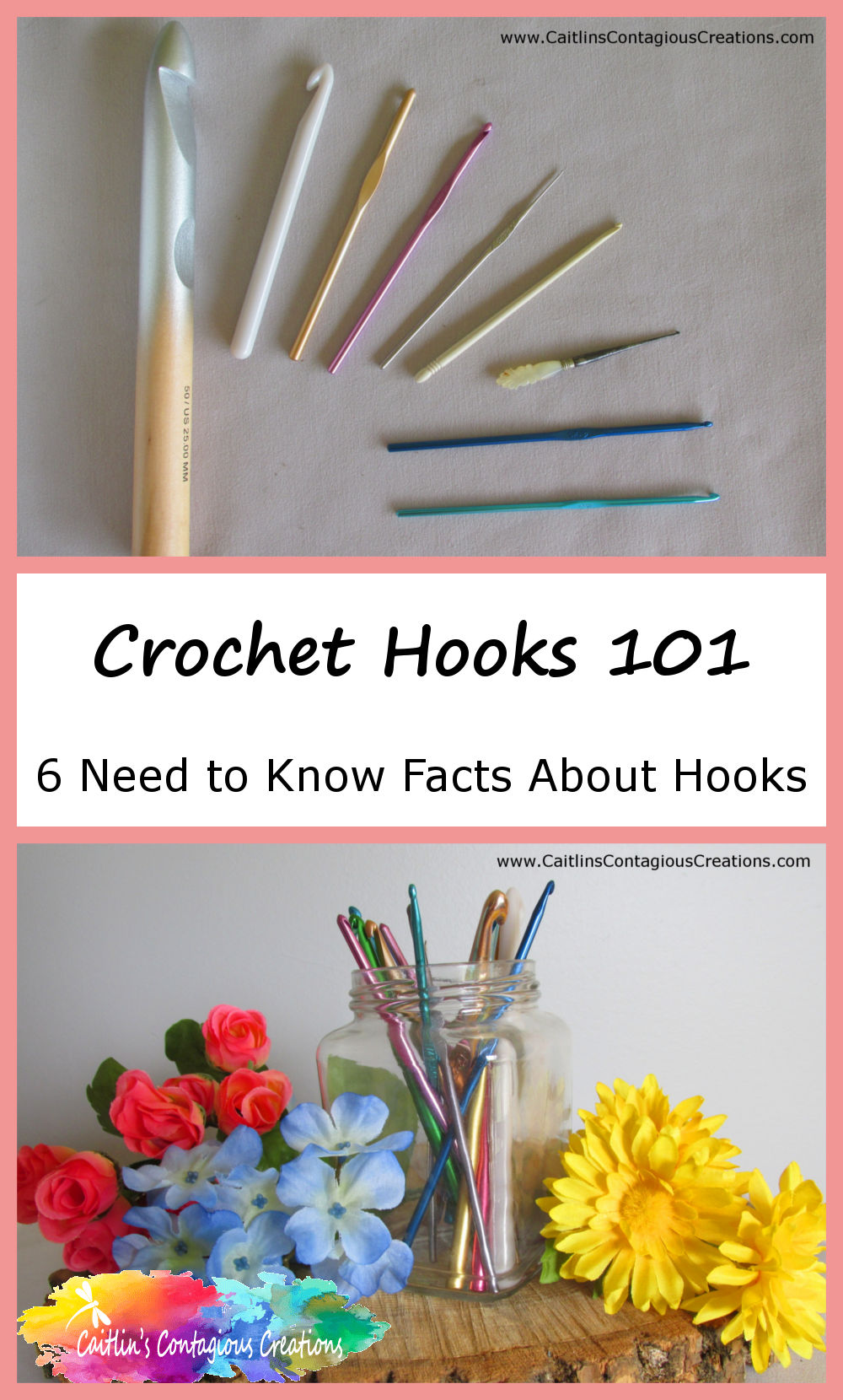
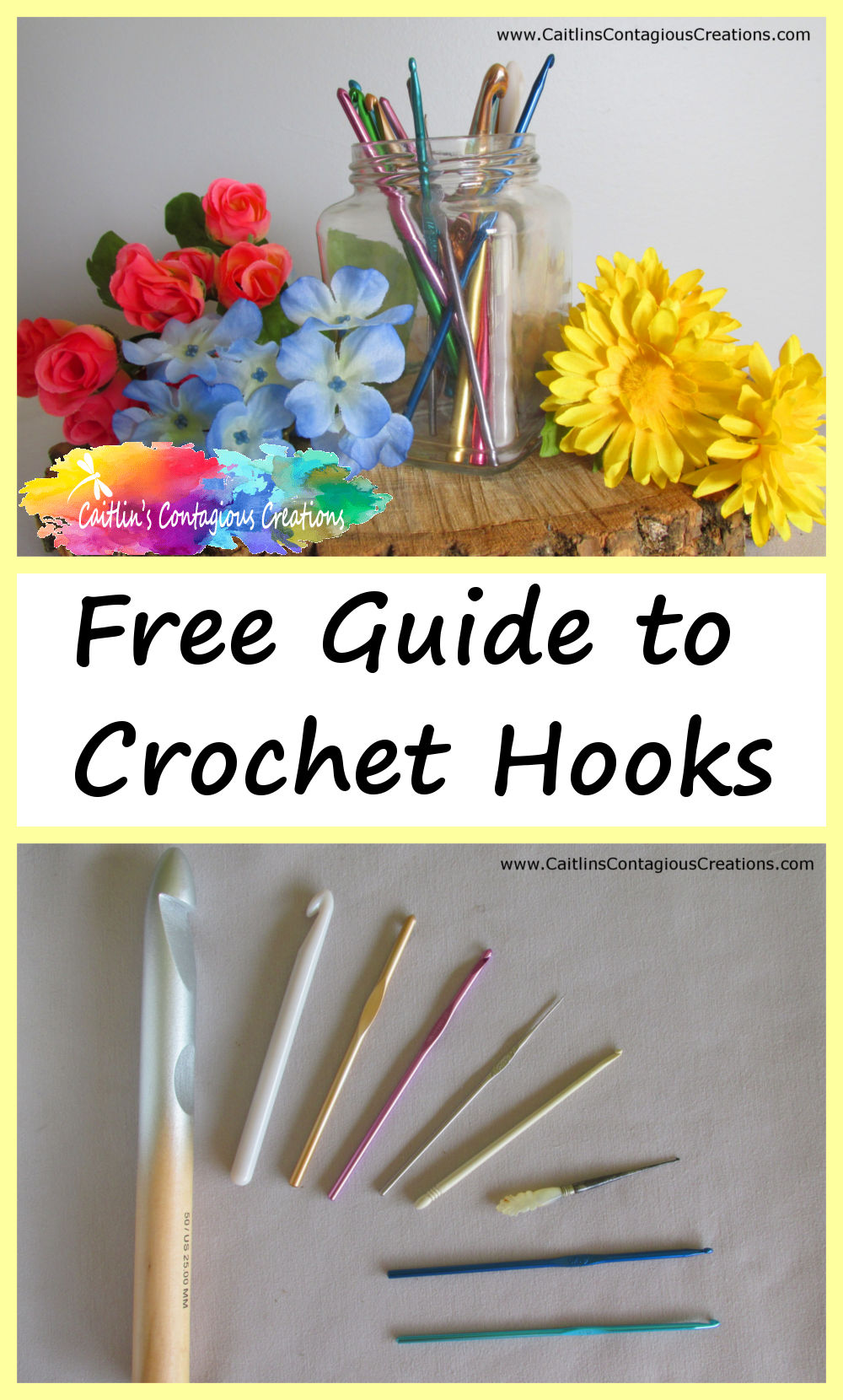





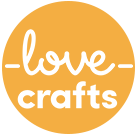
I don’t find many places that I am able to leave comments for you, so I am taking this opportunity to thank you so much for all your emails with tips and links to make my craft easier. I truly appreciate all you do for your readers! Be blessed, Caitlin!!
Sharon, Thank you so much for your kind words! I’m so glad to hear that you enjoy receiving my emails 🙂 ~Caitlin
Excellent info! Pinned ♥ If you haven’t already, why not linkup this post and more at my #UnlimitedMonthlyLinkParty 2 (open until July 26) and the #WednesdayAIMLinkParty 41 (starting the evening of July 17).
Dee, Thank you so much for the comment and the link party suggestions! I have not heard of those two yet, and will definitely be checking them out 🙂 ~Caitlin
I like Prym ergonomics crochet hooks . I am making scarfs and pattern calls for 5.5 needle but Prym only goes to size 5. Would using the 5 make that much of difference
Melinda, Thank you for your comment! I would recommend making a gauge swatch to answer your question. I couldn’t really tell you if the size 5 would work on not. Many times the hook size in a pattern is a recommendation based on the size yarn used and the designers tension. It is always a good idea to make a gauge swatch so you can know whether the project will still be a good size if you change the hook size. If the size of the finished project is not important then I would say you can use the smaller hook. I hope this helps!! ~Caitlin